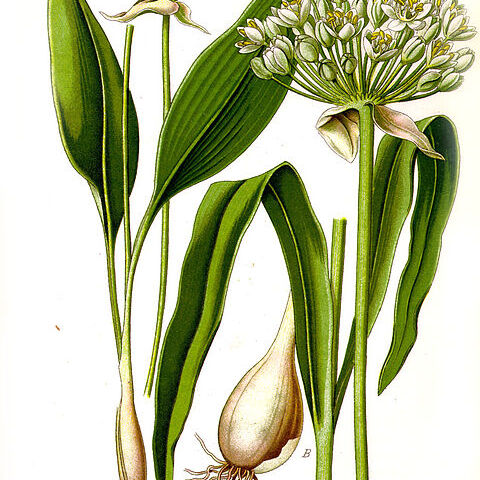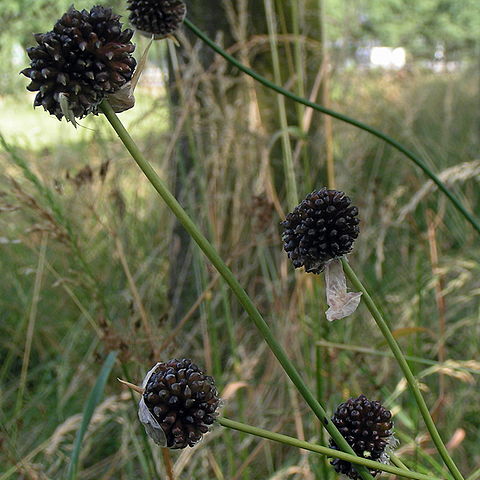Herbs perennial, bulbiferous, sometimes with well-developed, thick or thin rhizomes, rarely with stolons or tuberous roots, usually with onionlike, leeklike, or garliclike odor when fresh. Bulb covered with a tunic. Leaves sessile, very rarely narrowed into a petiole, with a closed leaf sheath at base, linear, linear-lanceolate, or lorate to orbicular-ovate, cross section flat, angled, or semiterete to terete, fistulose or solid. Scape terminal or lateral, sheathed or naked. Inflorescence a terminal umbel, sometimes with bulblets, rarely flowerless and with bulblets only, enclosed in a spathelike bract before anthesis. Pedicels with or without basal bracteoles. Flowers bisexual, very rarely degenerating into unisexual (when plants dioecious). Perianth segments free or united into a tube at base. Filaments usually connate at base and adnate to perianth segments, entire or toothed. Ovary with 1 to several ovules per locule; septa often containing nectaries opening by pores at base of ovary. Style simple; stigma entire or 3-cleft. Capsule loculicidal. Seeds black, rhomboidal or spheroidal.
Herbs, usually with onion-smell, bulbs often present, sometimes with short rhizomes, growing gregarious or not. Leaves linear to elliptic, sheathing the scape, the blades sub-approximate or scattered along the scape, flat, or terete, semiterete, or angular and hollow. Scape terete or angular. Inflorescence umbellate, usually many-flowered, sometimes with bulbils, hemispherical to spherical or ± ellipsoid, enveloped by 1 or 2 green or scarious, persistent or caducous spathe(s). Flowers relatively small, white to pinkish or purplish, bluish, or yellowish, stellate to campanulate or urceolate. Tepals 6, (sub)equal in length, elliptic to lanceolate, free or usually shortly connate at base, persistent. Stamens 6; filaments simple or tricuspidate. Ovary with 2-14 ovules per locule; style slender, erect; stigma usually inconspicuous, single or 3-lobed. Fruit capsular, loculicidally 3-valved. Seeds 1-4 per locule, flattened, irregularly angled, blackish.
Green or glaucous scapose perennials with onion-or garlic-like odour. Bulb tunicate, solitary, or often with stipitate offset bulbs. Leaves 1-many, all basal, sheathing scapes to varying levels, usually linear, solid or hollow. Flowers white, yellow or pink, campanulate, in few-to many-flowered terminal involucrate umbels; spathe-valves 2, ± united; bulbils often present between flowers, occasionally replacing them; perianth-segments free or ± connate at base. Staminal-filaments simple, divided, or with lateral appendages. Capsule ovoid to globose, 3-lobed, loculicidal. Seeds black, ± angular to flat, usually 6. Spp. c. 450, widely distributed in N. Hemisphere, mainly in temperate regions. Adventive spp. 4.
Fls perfect; tep 6, uniform in color but often somewhat unlike in shape or size, generally withering and persistent below the fr; stamens 6, often adnate to the base of the tep, the filaments of the epipetalous series often wider, or strongly flattened, or variously toothed; anthers short, introrse; ovules 1 or 2 per locule; capsule short, ovoid to globose or obovoid, 3-lobed, loculicidal; seeds black; herbs from a coated bulb, with a strong odor of onion or garlic, the lvs usually narrow, basal or on the lower part of the stem, the scape-like stem erect, terminated by a determinate umbel subtended by 1–3 bracts; fls white to pink or purple, sometimes replaced by sessile bulblets. 500, N. Hemisphere.
Herbaceous bulbous perennials usually with onion or garlic odour when bruised. Leaves basal or sheathing the scape to various heights, flat, triquetrous or terete, solid or hollow, usually linear. Inflorescence umbellate, with flowers sometimes partly or entirely replaced by sessile bulbils; spathe of several distinct or united bracts. Flowers bisexual, actinomorphic, pedicellate. Perianth segments 6, free or slightly united, persistent. Stamens 6; filaments filiform, linear or broadened; anthers dehiscing by slits, introrse. Ovary superior; locules 3; ovules usually 2 per locule and then almost basal; placentation axile; style gynobasic. Fruit a membranous capsule. Seeds usually 3–6, angled, black.


